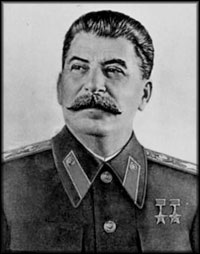 |
||
  |
||
|
|
The Origins of the Cold War, 1945-1949—Curriculum Unit Overview—IntroductionAlthough the alliance between the United States and the Soviet Union had brought victory in World War II, wartime cooperation meant glossing over many serious differences between the two. Since the Bolshevik Revolution of 1917, Soviet leaders had been claiming that communism and capitalism could never peacefully coexist. Beginning in the 1930s Josef Stalin had tried to reach some sort of understanding with the West, but only because he viewed Nazi Germany as the greater threat. Indeed, after concluding that the West was not interested in working with him, he made his own agreement with Hitler in 1939. That agreement, of course, was quickly forgotten after the German invasion of the Soviet Union two years later.After the United States entered the war in December 1941 the administration began encouraging Americans to view the Soviet Union not as a threat, but rather as a partner both for victory over the Axis and for maintaining peace in the postwar world. In newspaper and magazine articles, speeches and Hollywood films, Americans were told again and again that although the Russian people had a different economic system, they were equally committed to democratic values and to a peaceful, stable world order. This message, hammered home from 1942 to 1945, meant that after the war Americans would be in for a rude shock. Agreements regarding the postwar world were reached at Yalta and Potsdam, but the Soviets wasted no time in violating them. After driving German forces out of Eastern Europe they set about creating communist puppet states throughout the region, apparently ignoring their promises to allow democratic elections there. Having just won a world war, they seemed intent on setting the stage for another. To the new administration of Harry Truman, this behavior was reminiscent of Hitler's in the 1930s. Like many of the statesmen of his age, he believed that the proper means of responding to an international bully was a credible threat of force; "appeasement" was a dirty word, as it would only lead to new demands. Thus Truman decided on a strategy known as "containment," in which the Soviets would be prevented—militarily if necessary—from using force to export their ideology abroad. Containment would, in fact, remain the cornerstone of U.S. foreign policy for the next fifty years. Containment assumed many different forms. Under the Truman Doctrine the president pledged to defend "free peoples" everywhere through economic and military aid. The Marshall Plan provided billions of dollars for economic recovery to Western Europe, lest misery in France, Germany, and Italy lead to communist electoral victories in those countries. The North Atlantic Treaty Organization was a formal military alliance, and a clear message to Moscow—the United States would fight to defend Western Europe. Ultimately it would lead to actual war in Korea. Containment was not without its critics, and among the most perceptive was journalist Walter Lippman. Lippman believed that the result would be an ongoing "cold war" that might never involve actual combat, but would continue to drain American resources as the United States was committed to resist communism everywhere it might appear. And indeed, "Cold War" is exactly the term that has come to define the entire period from 1945 to 1989. In this curriculum unit students will learn how the Cold War began, from the agreements reached at Yalta and Potsdam in 1945 through the formation of NATO in 1949. Guiding Questions
Learning ObjectivesUpon completing all of the lessons in this unit, students will be able to:
Preparation for Teaching this Curriculum UnitReview each lesson plan. Locate and bookmark suggested materials and links from EDSITEment-reviewed websites used in this lesson. Download and print out selected documents and duplicate copies as necessary for student viewing. Alternatively, excerpted versions of these documents are available as part of the downloadable Text Documents.Download the Text Document for each lesson, available here as a PDF file. This file contains excerpted versions of the documents used in the various activities, as well as questions for students to answer. Print out and make an appropriate number of copies of the handouts you plan to use in class. Analyzing primary sourcesIf your students lack experience in dealing with primary sources, you might use one or more preliminary exercises to help them develop these skills. The Learning Page at the American Memory Project of the Library of Congress includes a set of such activities. Another useful resource is the Digital Classroom of the National Archives, which features a set of Document Analysis Worksheets.Unit LessonsEach lesson is designed to stand alone, occupying three to four class periods. Taken together they provide a fairly comprehensive approach to the early years of the Cold War. If there is not sufficient time to complete all three lessons, the second should have priority, followed by the first, and then the third.Lesson One: Sources of Discord, 1945-1946Lesson Two: The Strategy of Containment, 1947-1948Lesson Three: The Formation of the Western Alliance, 1948-1949Selected EDSITEment Web Site
Standards Alignment View your state’s standards |
||||||||||||||||||||||||||||||||||||||||||||||||||||||||||||||||||||||
  |
||
| EDSITEment contains a variety of links to other websites and references to resources available through government, nonprofit, and commercial entities. These links and references are provided solely for informational purposes and the convenience of the user. Their inclusion does not constitute an endorsement. For more information, please click the Disclaimer icon. | ||
| Disclaimer | Conditions of Use | Privacy Policy Search
| Site
Map | Contact
Us | ||
